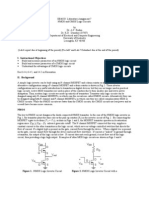L #6: L C C S L G: Sfsu - E 301 - E L AB Ogic Ircuit Haracteristics and Imple Ogic Ates
Uploaded by
Rudra MishraL #6: L C C S L G: Sfsu - E 301 - E L AB Ogic Ircuit Haracteristics and Imple Ogic Ates
Uploaded by
Rudra MishraSFSU - ENGR 301 ELECTRONICS LAB
LAB #6: LOGIC CIRCUIT CHARACTERISTICS AND SIMPLE LOGIC GATES
Updated July 30, 2003.
Objective:
To characterize BJT and CMOS inverters. To investigate simple logic gates. To compare measured and simulated logic circuits. 1 CD4007UB MOSFET Array, 1 2N2222A npn BJT, 4 1N4148 pn diodes, 1 0.1 F capacitor, and resistors: 1 1.0 k and 3 10 k (all 5%, W).
Components:
Instrumentation:
A bench power supply, a waveform generator (triangle/square wave), a digital voltmeter (DVM), and a dual-trace oscilloscope.
PART I THEORETICAL BACKGROUND
As we know, one of the most convenient ways to represent information is electronically, via voltage or current signals. A common example is the voltage waveform emerging from a microphone. Since this waveform is an electrical replica of the sound wave applied to the microphone, which is of mechanical nature, the microphone output is referred to as an analog signal. The part of electronics dealing with the amplification and processing of analog signals is aptly called analog electronics. In demanding situations such as hi-fi and precision instrumentation, analog electronics often faces extremely challenging tasks. Consider, for instance, an op amp circuit that at some given instant is required to output the voltage vO = V = 3.1415927 V. Because of component non-idealities, such as the op amps input offset error and inherent delays, the circuit might actually give vO = 3.1523362 V, thereby invalidating the significance of all digits following the 4, and corrupting even the 4 as it is being rendered as a 5 instead of a 4. Digital electronics circumvents the inherent limitations of analog electronics by representing information via binary signals, such as a voltage that is restricted to assume only two values, vO = VOL (L for Low) and vO = VOH (H for High). If these values are sufficiently well separated from each other, such as VOL 0 V and VOH 5 V, then even the crudest circuits would be capable to generate them as well as to interpret them correctly. A binary digit, or bit for short, represents the tiniest piece of information possible. If we were to use it as basis for course grades, we would have only 2 possibilities, say, H for Pass, and L for Fail. A better bet would be to use 2 bits, for then we would have 4 possible combinations, say, HH for a letter grade of A, HL for B, LH for C, and LL for D. If we wanted to encode also the letter grade of F as well as intermediate grades such as A, B+, B, and so forth, then we would need a total of 12 combinations. This can be achieved with 4 bits, which provide 16 possible combinations, HHHH, HHHL, HHLH LLLH, LLLL. The four remaining combinations could be used to encode something else, like Freshman, Sophomore, Junior, and Senior. Luckily enough, the number of possibilities increases exponentially (2n) with the number n of bits. For instance, with n = 10, we can represent 210 = 1024 different possibilities, a number commonly referred to as k for kilo. Likewise, 220 = 1,048,576 is called M for Mega. Though extremely convenient for the processing, transmission, and storage of information, digital electronics is not the answer to everything. Nature is inherently analog, so there will always be a need for analog circuits as well as competent analog engineers to design them. A popular example is offered by digital audio. Here, the tiny analog signals available from microphones and various musical
2002 Sergio Franco Engr 301 Lab #6 Page 1 of 11
instrument pickups are suitably amplified and conditioned via analog circuitry. They are then converted to digital form via analog-to-digital (A/D) converter circuits, whence they are manipulated via suitable digital signal processing (DSP) circuitry for mixing as well as the creation of special effects, and finally burned into a CD for storage, transportation, and sale. At the users end, suitable digital-to-analog (D/A) circuitry converts the CDs digital data back to analog form, for further amplification by power amplifiers and finally for the conversion back to sound waves via the loudspeakers. Todays tendency is thus as follows: Perform as many functions as possible in digital form, keeping in mind that nature presents itself predominantly in analog form, so that the electronic interface between real world and digital systems is analog.
Basic Logic Gates:
Figure 1 shows the three most common circuits for processing binary signals: the Inverter, the NAND gate, and the NOR gate. Shown immediately below are their truth tables, representing the output Y for all possible input combinations. Gates are made up of transistors and thus exhibit distinctive electrical characteristics. It is the intent of this lab to investigate them. The issues of greatest concern in the application of logic gates are (a) their ability to correctly produce as well as interpret binary signals in the presence of noise and other forms of disturbance, (b) how long it takes for a gate to evaluate its input combination and yield the correct output, and (c) how much power a gate takes to operate. These issues are best illustrated for the case of the inverter, the most basic of logic circuits. Of course, to build a complex digital system we need more sophisticated logic circuits such a NAND and NOR gates, flipflops, encoders/decoders, registers, and memories. However, when it comes to the study of electrical properties, the basic inverter, in spite of its simplicity, is fairly representative of most logic circuits, so we find it appropriate to investigate it in proper detail.
Noise Margins:
As a signal produced by a transmitting gate travels down a wire, it picks up various forms of noise, so by the time it reaches a receiving gate it may be appreciably contaminated. The question arises as to how much noise can be tolerated at the receiving end and still allow for the signal to be interpreted correctly there. A logic familys ability to function correctly in noisy environments is measured via its noise margins. As shown in Fig. 2(a), an inverter is powered between VS (typically 5 V) and ground. Circuit behavior is best visualized via the voltage transfer curve (VTC), representing the plot of vO versus vI. Figure 2(b) shows the idealized VTC. For vI < 0.5VS the circuit gives vO = VS (= VOH), and for vI > 0.5VS it gives vO = 0 V (= VOL). The VTC of a practical inverter will generally depart from this idealized shape,
(a )
(b)
(c)
Fig. 1 Circuit symbols and truth tables for the basic logic gates: (a) the Inverter, (b) the NAND
gate, and (c) the NOR gate.
2002 Sergio Franco Engr 301 Lab #6 Page 2 of 11
(a )
(b)
(c)
Fig. 2 (a) Logic inverter. (b) Idealized VTC, and (c) practical VTC.
and will look more like that of Fig. 2(c). Here we observe that as long as vI is sufficiently low (near 0V), the inverter gives vO = VOH (note that VOH is not necessarily VS); as long as vI is sufficiently high (near VS), the inverter gives vO = VOL (note that VOL is not necessarily 0 V). The departure of a practical VTC from the ideal is specified in terms of the noise margins, defined as NML = VIL VOL NMH = VOH VIH (1a) (1b)
where VIL and VIH are the values of vI corresponding to the points of the VTC where slope is 1 V/V. Physically, the noise margins represent the maximum amount of noise that can be tolerated on a line going from the output of a transmitting gate to the input of a receiving gate. As illustrated further in Fig. 3, any noise in excess of this margin will be amplified by the receiving gate by more than unity, potentially leading to erroneous circuit behavior. Clearly, the higher the noise margins, the better. For the idealized VTC of Fig. 2(b) we have NML = NMH = 0.5VS (= 2.5 V for VS = 5 V). VTCs are readily visualized with a dual-trace oscilloscope operated in the x-y mode, or via
Fig. 3 Visualizing the noise margins
2002 Sergio Franco
Engr 301 Lab #6 Page 3 of 11
VCC RC 5Vdc vI 0Vdc RB Q1
V
1k
10k Q2N2222
0
Fig. 4 BJT inverter and its VTC.
PSpice using a DC Sweep. Figure 4 shows a PSpice inverter based on the familiar 2N2222 BJT, along with its VTC. This circuit has been simulated using the 2N2222 model available in PSpicess library. As we know from Lab #4, the input sweep carries the BJT from the cutoff (CO) region, to the edge of conduction (EOC), through the forward-active (FA) region, to the edge of saturation (EOS), and thence into deep saturation (Sat). One can use simple graphical techniques to identify the points where slope is 1 V/V, and then determine VIL and VIH. Moreover, one can use the cursor to find the values of VOL and VOH, and thus calculate the noise margins via Eq. (1). Figure 5 shows a PSpice inverter of the CMOS type, along with its VTC. This circuit has been simulated using two homebrew MOSFETs, called respectively 301pMOSFET and 301nMOSFET. Both devices have been created by renaming and suitably editing the PSpice Models of two MOSFETs available in the PSpice Library. This has been done first by clicking the device to select it, then by clicking Edit PSpice Model to change the values of its parameters. Following are the model statements for the two devices: .model 301pMOSFET .model 301nMOSFET PMOS(W=20u L=5u kp=20u Vto=-1.75 lambda=0.08) NMOS(W=10u L=5u kp=50u Vto=1.5 lambda=0.05)
As shown on the VTC itself, the input sweep carries the two MOSFETs, denoted respectively as Mp and Mn, thorough the regions indicated, where CO indicates the cutoff region, the ohmic region, and PO the pinch-off region. Again, from the VTC one can readily find the noise margins using simple graphical technique. You can simulate both inverters by downloading their appropriate files from the Web. To this end, go to http://online.sfsu.edu/~sfranco/CoursesAndLabs/Labs/301Labs.html, and once there, click on PSpice Examples. Then, follow the instructions contained in the Readme file.
2002 Sergio Franco Engr 301 Lab #6 Page 4 of 11
VDD 301pMOSFET Mp vI 0Vdc Mn 301nMOSFET
5Vdc
vO
V
Fig. 5 CMOS inverter and its VTC.
Propagation Delays:
An inverters response to a sharp-edged input pulse is not instantaneous, as the circuit takes a certain amount of time to swing its output from one level to the other (see Fig. 6). The speed of response is characterized in terms of the propagation delays tPLH and tPHL. The amount of time, following the leading edge vI, that it takes for vO to swing from VOH down to the transitions midpoint, defined as V50% = VOL + VOH 2 (2)
is denoted as tPHL. Likewise, the amount of time, following the trailing edge of vI , that it takes for vO to swing from VOL up to V50% is denoted as tPLH. The two delays are not necessarily identical, so their average
Fig. 6 Illustrating the propagation delays.
2002 Sergio Franco
Engr 301 Lab #6 Page 5 of 11
tP =
t PLH + t PHL 2
(3)
is aptly called the average propagation delay. Figure 7 shows the pulse response of the basic BJT inverter. One can readily measure the propagation delays using the cursor facility of PSpice. The results are tPHL 75 ns and tPLH 630 ns. These delays stem from the fact that it takes time to build up/remove charge in the junction capacitances of the BJT as well as the excess minority charge inside the base region. These functions are performed by the base current. During tPHL the base current is IBF (5 0.7)/10 = 0.43 mA, and it flows into the BJT to buildup charge. During tPLH the base current is IBR (0 0.7)/10 = 0.07 mA, the minus sign indicating that IBR flows out of the BJT, thus removing the charge built up by IBF. The asymmetry in the values of tPHL and tPLH stems in part from the different magnitudes of IBF and IBR. A particularly undesirable component of tPLH is the storage time tS, representing the amount of time it takes for IBR to remove the charge stored the base of the BJT when it was driven past the EOS, into deep saturation. It can be proved that the storage time can be calculated as tS = S ln I BF I BR I B (EOS) I BR (4)
where S is a characteristic parameter of the BJT called the saturation time constant, in ns, and IB(EOS) is the base current needed to bring the BJT to the edge of saturation, or IB(EOS) = IC(EOS)/F. For our circuit, IC(EOS) (5 0.2)/1 = 4.8 mA. Using the cursor facility of PSpice, we readily find tS 430 ns. In the case of CMOS gates there are no charge storage effects. However, there are still parasitic capacitances internal to the MOSFETs that need to be charged/discharged, thus causing nonzero propagation delays. A convenient way to find average propagation delays experimentally is to connect an odd number n of inverters in ring fashion, as depicted in Fig. 8 for the case n = 3. It is readily seen that the counters period of oscillation is T = 2ntP or T = 6tP in our example. One can thus measure T with the oscilloscope, and then divide by 6 to find the experimental value of tP.
VCC RC Q1 5Vdc V1 = 0 TD = 200ns V2 = 5 vI TR = 2ns TF = 2ns PW = 1us PER = 4us RB
V V
1k vO
10k
Q2N2222
0
Fig. 7 Basic BJT inverter and its pulse response.
2002 Sergio Franco
Engr 301 Lab #6 Page 6 of 11
Fig. 8 Ring oscillator and its waveforms.
PART II EXPERIMENTAL PART
This experiment is based on the 2N2222 npn BJT and the CD4407UB CMOSFET Array. You are urged to download their data sheets from the Web. To this end, go to http://www.google.com and search for CD4007UB and 2N2222, or variants thereof. The pin configurations of these devices are repeated in Fig. 9 for your convenience. As stressed many times, be careful (a) to assemble your circuits with power off, (b) to keep leads short, and (b) to bypass the power supply to ground via a 0.1-F capacitor. Henceforth, steps shall be identified by letters as follows: C for calculations, M for measurements, P for prelab work, and S for SPICE simulation.
BJT Inverter:
The basic inverter of Fig. 4, though useful to illustrate how a BJT performs the logic function of inversion, is inadequate from a practical standpoint as it offers poor NML and excessively long storage. It is also susceptible to loading when connected to similar gates, indicating a drop in the value of VOH and, hence, a reduction in NMH. The improved inverter of Fig. 10a is of the so-called DTL (Diode-Transistor Logic) type, a precursor of the more popular TTL (Transistor-Transistor Logic) type. The function of D1 and D2 is to shift the VTC toward the right and thus improve NML, while that of R3 to help shut off the BJT during the storage time. Moreover, the base drive network has been redesigned so that with DA
Fig. 9 Pin configuration for the 2N2222 npn BJT and the CD4007UB CMOS Array.
2002 Sergio Franco Engr 301 Lab #6 Page 7 of 11
Fig. 10 DTL-type inverter.
reverse biased it will not load a similar gate upstream. PSC1: Use PSpice to display the VTC of the BJT inverter of Fig. 10 (for the diodes and the BJT, use the models available in PSpices library.) Hence, use graphical techniques to determine its noise margins. PSC2: Use PSpice to display the pulse response of the BJT inverter of Fig. 10, in the manner of Fig. 7. Hence, use the cursor facility of PSpice to find its propagation delays. MC3: With power off, assemble the circuit of Fig. 10. Hence, apply power, display its VTC on the oscilloscope, and determine its noise margins graphically. Finally, compare with your findings of Step PSC1, and account for possible differences. Note: To observe the VTC experimentally, first adjust the waveform generator so that vI is a 100-Hz triangular wave alternating between 0 V and 5 V (make your adjustments using Ch. 1 of the oscilloscope, DC Mode, Trigger from Ch. 1). Next, switch the oscilloscope to the x-y Mode, set both channels to 1 V/div, DC, and adjust the offsets so that the origin of the x-y display (dot) is at the lower left corner of the screen. Finally, feed vI to the x-axis and vO to the y-axis. M4: In the circuit of Fig. 10 adjust the waveform generator so that vI is a 250-kHz pulse train
Fig. 11 DTL-type logic gate.
2002 Sergio Franco Engr 301 Lab #6 Page 8 of 11
alternating between 0 V and 5 V (make your adjustments using Ch. 1 of the oscilloscope, DC Mode, Trigger from Ch. 1). Hence, while monitoring vO with Ch. 2 (1 V/div, DC), determine the propagation delays. How do they compare with those of Step PSC2? (For optimum visualization, you may need to vary the frequency from the suggested initial value of 200 kHz.)
A BJT Logic Gate:
MC5: With power off, add diode DB as shown in Fig. 11. Reapply power, and while monitoring Y with the DVM, record in the adjoining table the values of Y (H or L) as well as the states (ON or CO) of the diodes and the BJT for each of the four input combinations shown (L = 0 V, H = 5 V). What logic function does your gate provide? CMOS Inverters: PSC6: Use PSpice to display the VTC of the CMOS inverter of Fig. 12a. Hence, use graphical techniques to determine its noise margins. Note: The PSpice library does not come with models for the DC4007 MOSFETs. You are therefore to create your own models, using the values of kn, Vtn, n, and kp, Vtp, p found experimentally in Lab #5. MC7: With power off, assemble the circuit of Fig. 12a. Next, apply power, and follow the procedure of Step MC3 to display its VTC on the oscilloscope. Finally, find its noise margins graphically, compare with your findings of Step PSC6, and account for possible differences. MC8: With power off, assemble the circuit of Fig. 12b, consisting of three inverters connected in cascade, so that the composite circuit, known as a buffered inverter, still provides the logic function of inversion. Next, apply power, and follow the procedure of Step MC7 to display its VTC on the oscilloscope. Finally, find its noise margins, compare with the basic inverter of Fig. 12a, and justify the reason for the buffered inverters much improved noise margins. MC9: With power off, disconnect the waveform generator from the circuit of Fig. 12b, and connect the
(a ) Fig. 12 CMOS inverters: (a) basic type, and (b) buffered type.
2002 Sergio Franco
(b )
Engr 301 Lab #6 Page 9 of 11
Fig. 13 CMOS ring counter
output of the rightmost inverter back to the input of the leftmost one, to turn the circuit into a ring counter with n = 3, as shown in Fig. 13. Apply power, measure the period T of oscillation with the oscilloscope, and obtain the average propagation delay as tP = T/6. How does it compare with that of the BJT inverter of Step M4, given that there are no charge storage effects in MOSFETs? CMOS Logic Gates: M10: With power off, assemble the circuit of Fig. 14. Apply power, and while monitoring Y with the DVM, record in the adjoining table the values of Y (H or L) as well as the states ( or CO) of the
Fig. 14 A CMOS logic gate.
2002 Sergio Franco
Engr 301 Lab #6 Page 10 of 11
Fig. 15 Another CMOS logic gate.
MOSFETs for each of the four input combinations shown (L = 0 V, H = 5 V). What logic function does your gate provide? M11: Repeat Step M10, but for the CMOS gate of Fig. 15.
2002 Sergio Franco
Engr 301 Lab #6 Page 11 of 11
You might also like
- Digital Electronics I: Logic, Flip-Flops, and Clocks: PurposeNo ratings yetDigital Electronics I: Logic, Flip-Flops, and Clocks: Purpose13 pages
- Experiment 1 Basic Logic Gates: Objectives100% (1)Experiment 1 Basic Logic Gates: Objectives10 pages
- Lecture 5: Physical Realisation of Logic Gates: DOC112: Computer Hardware Lecture 5 1100% (1)Lecture 5: Physical Realisation of Logic Gates: DOC112: Computer Hardware Lecture 5 14 pages
- Chapter Two: Basic Combinational CircuitsNo ratings yetChapter Two: Basic Combinational Circuits8 pages
- Digital Electronics I: Logic, Flip-Flops, and Clocks: PurposeNo ratings yetDigital Electronics I: Logic, Flip-Flops, and Clocks: Purpose13 pages
- Y-0020-01 Basic Level Digital Electronics PDFNo ratings yetY-0020-01 Basic Level Digital Electronics PDF86 pages
- Circuits For Electronic Instrumentation - T.H.O'Dell100% (1)Circuits For Electronic Instrumentation - T.H.O'Dell232 pages
- Key Concepts in Digital Logic Design-MergedNo ratings yetKey Concepts in Digital Logic Design-Merged33 pages
- Paper-4 Voltage Controlled, Low-Pass and High-Pass Filter Using Analog MultiplierNo ratings yetPaper-4 Voltage Controlled, Low-Pass and High-Pass Filter Using Analog Multiplier8 pages
- Sum A B Cin Cout A B + A Cin + B Cin: Figure 4.1 Truth TableNo ratings yetSum A B Cin Cout A B + A Cin + B Cin: Figure 4.1 Truth Table6 pages
- Introduction To Digital Electronics: Objective and OverviewNo ratings yetIntroduction To Digital Electronics: Objective and Overview7 pages
- Elec 2210 - Experiment 1 Basic Digital Logic Circuits: ObjectivesNo ratings yetElec 2210 - Experiment 1 Basic Digital Logic Circuits: Objectives5 pages
- D06 - Trang Bi Dien - Week - 06 - and - 07No ratings yetD06 - Trang Bi Dien - Week - 06 - and - 0761 pages
- Figure 8-7 Determining The Voltage Gain For The Common-Emitter Transistor AmplifierNo ratings yetFigure 8-7 Determining The Voltage Gain For The Common-Emitter Transistor Amplifier9 pages
- Department of Electronics and Communication Engineering: Ajalakshmi Ngineering OllegeNo ratings yetDepartment of Electronics and Communication Engineering: Ajalakshmi Ngineering Ollege26 pages
- Digital Integrated Electronics-: Use of The Book Presumes Some Background in SemiNo ratings yetDigital Integrated Electronics-: Use of The Book Presumes Some Background in Semi2 pages
- UNIT 4: Fundamentals of Semiconductor Devices and Digital CircuitsNo ratings yetUNIT 4: Fundamentals of Semiconductor Devices and Digital Circuits338 pages
- Reference Guide To Useful Electronic Circuits And Circuit Design Techniques - Part 1From EverandReference Guide To Useful Electronic Circuits And Circuit Design Techniques - Part 12.5/5 (3)
- Lab 5: Computer Simulation of RLC Circuit Response Using PspiceNo ratings yetLab 5: Computer Simulation of RLC Circuit Response Using Pspice8 pages
- L #2: O A C: Sfsu - E 301 - E L AB Perational Mplifier HaracteristicsNo ratings yetL #2: O A C: Sfsu - E 301 - E L AB Perational Mplifier Haracteristics13 pages
- ECE2274 Pre-Lab For MOSFET Logic NAND Gate, NOR Gate, and CMOS Inverter 1. Nmos Nand GateNo ratings yetECE2274 Pre-Lab For MOSFET Logic NAND Gate, NOR Gate, and CMOS Inverter 1. Nmos Nand Gate6 pages
- L #5: Mosfet C A: Sfsu - E 301 - E L AB Haracteristics and PplicationsNo ratings yetL #5: Mosfet C A: Sfsu - E 301 - E L AB Haracteristics and Pplications14 pages
- L #3: D C A: Sfsu - E 301 - E L AB Iode Haracteristics and PplicationsNo ratings yetL #3: D C A: Sfsu - E 301 - E L AB Iode Haracteristics and Pplications12 pages
- L #1: T F R S C: Sfsu - E 301 - E L AB Ime and Requency Esponses of Eries IrcuitsNo ratings yetL #1: T F R S C: Sfsu - E 301 - E L AB Ime and Requency Esponses of Eries Ircuits8 pages
- L #1: T F R S C: Sfsu - E 301 - E L AB Ime and Requency Esponses of Eries IrcuitsNo ratings yetL #1: T F R S C: Sfsu - E 301 - E L AB Ime and Requency Esponses of Eries Ircuits8 pages
- Ikslv Gkoszlv Rduhdh, Oa Ewy Lao/Kzu Esa Izek.K&I Lh0Ih0, P0Vh0 ,.M Oh0,0No ratings yetIkslv Gkoszlv Rduhdh, Oa Ewy Lao/Kzu Esa Izek.K&I Lh0Ih0, P0Vh0 ,.M Oh0,014 pages
- D A T E - 3 1 / 0 8 / 1 3 Experiment No.3 Page No.6No ratings yetD A T E - 3 1 / 0 8 / 1 3 Experiment No.3 Page No.61 page
- 2010 - Ahn&Longman - EXAMINING THE PROPERTIES OF THE WATERBED EFFECT IN SPACECRAFT DISTURBANCE REJECTION CONTROL SYSTEMS PDFNo ratings yet2010 - Ahn&Longman - EXAMINING THE PROPERTIES OF THE WATERBED EFFECT IN SPACECRAFT DISTURBANCE REJECTION CONTROL SYSTEMS PDF20 pages
- Honeywell RTH8500 Wifi Thermostat Users GuideNo ratings yetHoneywell RTH8500 Wifi Thermostat Users Guide148 pages
- PWM Controller For ZVS Half Bridge: EaturesNo ratings yetPWM Controller For ZVS Half Bridge: Eatures41 pages
- Solar Powered Mobile Operated Smart Multifunction Agriculture RobotNo ratings yetSolar Powered Mobile Operated Smart Multifunction Agriculture Robot4 pages
- User Manual HPS 70009000 Series Single Phase Grid Tied Photovoltaic InverterNo ratings yetUser Manual HPS 70009000 Series Single Phase Grid Tied Photovoltaic Inverter33 pages
- Transformer Protection - Abstract From NEC - EEP100% (1)Transformer Protection - Abstract From NEC - EEP7 pages
- Allama Iqbal Open University, Islamabad (Department of Computer Science) WarningNo ratings yetAllama Iqbal Open University, Islamabad (Department of Computer Science) Warning4 pages
- Disk Cloning For Data Recovery With GNU Ddrescue PDFNo ratings yetDisk Cloning For Data Recovery With GNU Ddrescue PDF2 pages
- A New DC Breaker Used As Metallic Return Iransfer BreakerNo ratings yetA New DC Breaker Used As Metallic Return Iransfer Breaker10 pages
- Design of A Low Cost BPSK Modulator/demodulator For A Practical Illustration of Digital ModulationsNo ratings yetDesign of A Low Cost BPSK Modulator/demodulator For A Practical Illustration of Digital Modulations7 pages
- Hidden Camera Detection: Vaishali Koul, Rakshita Macheri, Ribhuvats, Liya Baby, Poonam BariNo ratings yetHidden Camera Detection: Vaishali Koul, Rakshita Macheri, Ribhuvats, Liya Baby, Poonam Bari5 pages
- List of Experiments: Ge8261-Engineering Practices Laboratory - Group BNo ratings yetList of Experiments: Ge8261-Engineering Practices Laboratory - Group B57 pages
- Windows XP - Step by Step Install - PPTNo ratings yetWindows XP - Step by Step Install - PPT51 pages
- Digital Electronics I: Logic, Flip-Flops, and Clocks: PurposeDigital Electronics I: Logic, Flip-Flops, and Clocks: Purpose
- Lecture 5: Physical Realisation of Logic Gates: DOC112: Computer Hardware Lecture 5 1Lecture 5: Physical Realisation of Logic Gates: DOC112: Computer Hardware Lecture 5 1
- Digital Electronics I: Logic, Flip-Flops, and Clocks: PurposeDigital Electronics I: Logic, Flip-Flops, and Clocks: Purpose
- Circuits For Electronic Instrumentation - T.H.O'DellCircuits For Electronic Instrumentation - T.H.O'Dell
- Paper-4 Voltage Controlled, Low-Pass and High-Pass Filter Using Analog MultiplierPaper-4 Voltage Controlled, Low-Pass and High-Pass Filter Using Analog Multiplier
- Sum A B Cin Cout A B + A Cin + B Cin: Figure 4.1 Truth TableSum A B Cin Cout A B + A Cin + B Cin: Figure 4.1 Truth Table
- Introduction To Digital Electronics: Objective and OverviewIntroduction To Digital Electronics: Objective and Overview
- Elec 2210 - Experiment 1 Basic Digital Logic Circuits: ObjectivesElec 2210 - Experiment 1 Basic Digital Logic Circuits: Objectives
- Figure 8-7 Determining The Voltage Gain For The Common-Emitter Transistor AmplifierFigure 8-7 Determining The Voltage Gain For The Common-Emitter Transistor Amplifier
- Department of Electronics and Communication Engineering: Ajalakshmi Ngineering OllegeDepartment of Electronics and Communication Engineering: Ajalakshmi Ngineering Ollege
- Digital Integrated Electronics-: Use of The Book Presumes Some Background in SemiDigital Integrated Electronics-: Use of The Book Presumes Some Background in Semi
- UNIT 4: Fundamentals of Semiconductor Devices and Digital CircuitsUNIT 4: Fundamentals of Semiconductor Devices and Digital Circuits
- Analog Dialogue, Volume 48, Number 1: Analog Dialogue, #13From EverandAnalog Dialogue, Volume 48, Number 1: Analog Dialogue, #13
- Reference Guide To Useful Electronic Circuits And Circuit Design Techniques - Part 1From EverandReference Guide To Useful Electronic Circuits And Circuit Design Techniques - Part 1
- Analog Dialogue, Volume 45, Number 3: Analog Dialogue, #3From EverandAnalog Dialogue, Volume 45, Number 3: Analog Dialogue, #3
- Lab 5: Computer Simulation of RLC Circuit Response Using PspiceLab 5: Computer Simulation of RLC Circuit Response Using Pspice
- L #2: O A C: Sfsu - E 301 - E L AB Perational Mplifier HaracteristicsL #2: O A C: Sfsu - E 301 - E L AB Perational Mplifier Haracteristics
- ECE2274 Pre-Lab For MOSFET Logic NAND Gate, NOR Gate, and CMOS Inverter 1. Nmos Nand GateECE2274 Pre-Lab For MOSFET Logic NAND Gate, NOR Gate, and CMOS Inverter 1. Nmos Nand Gate
- L #5: Mosfet C A: Sfsu - E 301 - E L AB Haracteristics and PplicationsL #5: Mosfet C A: Sfsu - E 301 - E L AB Haracteristics and Pplications
- L #3: D C A: Sfsu - E 301 - E L AB Iode Haracteristics and PplicationsL #3: D C A: Sfsu - E 301 - E L AB Iode Haracteristics and Pplications
- L #1: T F R S C: Sfsu - E 301 - E L AB Ime and Requency Esponses of Eries IrcuitsL #1: T F R S C: Sfsu - E 301 - E L AB Ime and Requency Esponses of Eries Ircuits
- L #1: T F R S C: Sfsu - E 301 - E L AB Ime and Requency Esponses of Eries IrcuitsL #1: T F R S C: Sfsu - E 301 - E L AB Ime and Requency Esponses of Eries Ircuits
- Ikslv Gkoszlv Rduhdh, Oa Ewy Lao/Kzu Esa Izek.K&I Lh0Ih0, P0Vh0 ,.M Oh0,0Ikslv Gkoszlv Rduhdh, Oa Ewy Lao/Kzu Esa Izek.K&I Lh0Ih0, P0Vh0 ,.M Oh0,0
- D A T E - 3 1 / 0 8 / 1 3 Experiment No.3 Page No.6D A T E - 3 1 / 0 8 / 1 3 Experiment No.3 Page No.6
- 2010 - Ahn&Longman - EXAMINING THE PROPERTIES OF THE WATERBED EFFECT IN SPACECRAFT DISTURBANCE REJECTION CONTROL SYSTEMS PDF2010 - Ahn&Longman - EXAMINING THE PROPERTIES OF THE WATERBED EFFECT IN SPACECRAFT DISTURBANCE REJECTION CONTROL SYSTEMS PDF
- Solar Powered Mobile Operated Smart Multifunction Agriculture RobotSolar Powered Mobile Operated Smart Multifunction Agriculture Robot
- User Manual HPS 70009000 Series Single Phase Grid Tied Photovoltaic InverterUser Manual HPS 70009000 Series Single Phase Grid Tied Photovoltaic Inverter
- Allama Iqbal Open University, Islamabad (Department of Computer Science) WarningAllama Iqbal Open University, Islamabad (Department of Computer Science) Warning
- Disk Cloning For Data Recovery With GNU Ddrescue PDFDisk Cloning For Data Recovery With GNU Ddrescue PDF
- A New DC Breaker Used As Metallic Return Iransfer BreakerA New DC Breaker Used As Metallic Return Iransfer Breaker
- Design of A Low Cost BPSK Modulator/demodulator For A Practical Illustration of Digital ModulationsDesign of A Low Cost BPSK Modulator/demodulator For A Practical Illustration of Digital Modulations
- Hidden Camera Detection: Vaishali Koul, Rakshita Macheri, Ribhuvats, Liya Baby, Poonam BariHidden Camera Detection: Vaishali Koul, Rakshita Macheri, Ribhuvats, Liya Baby, Poonam Bari
- List of Experiments: Ge8261-Engineering Practices Laboratory - Group BList of Experiments: Ge8261-Engineering Practices Laboratory - Group B







































































































